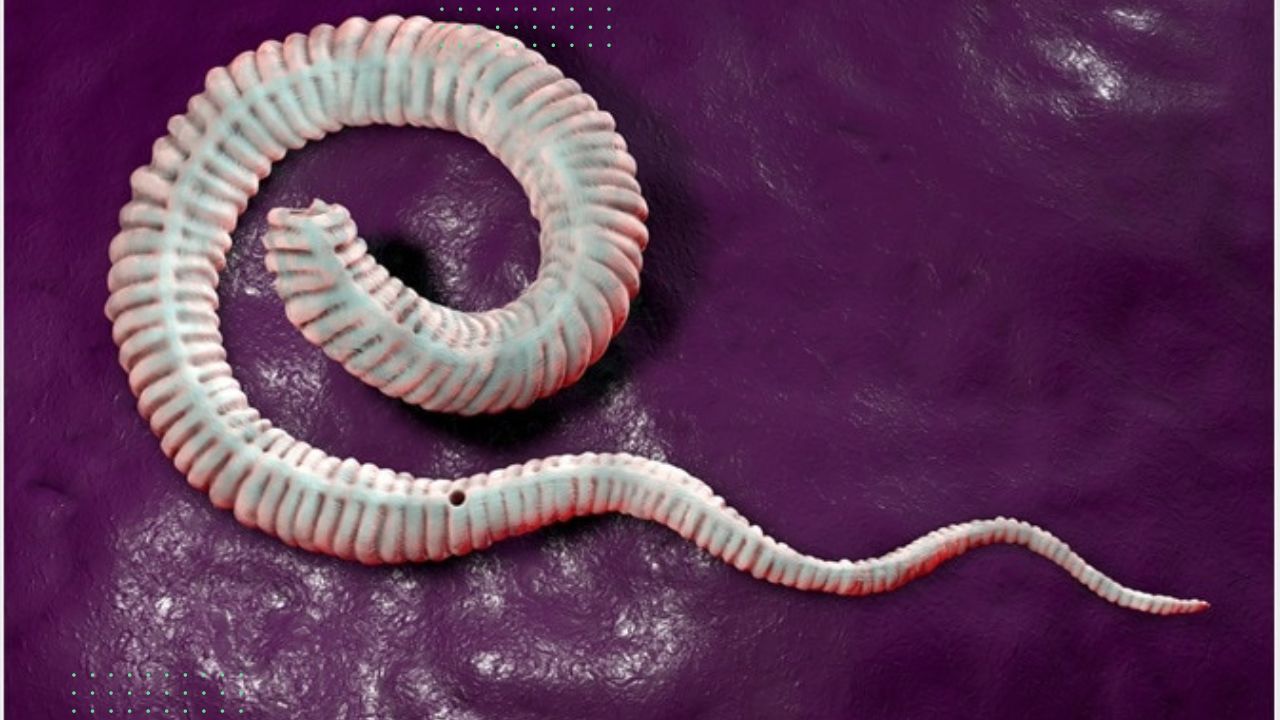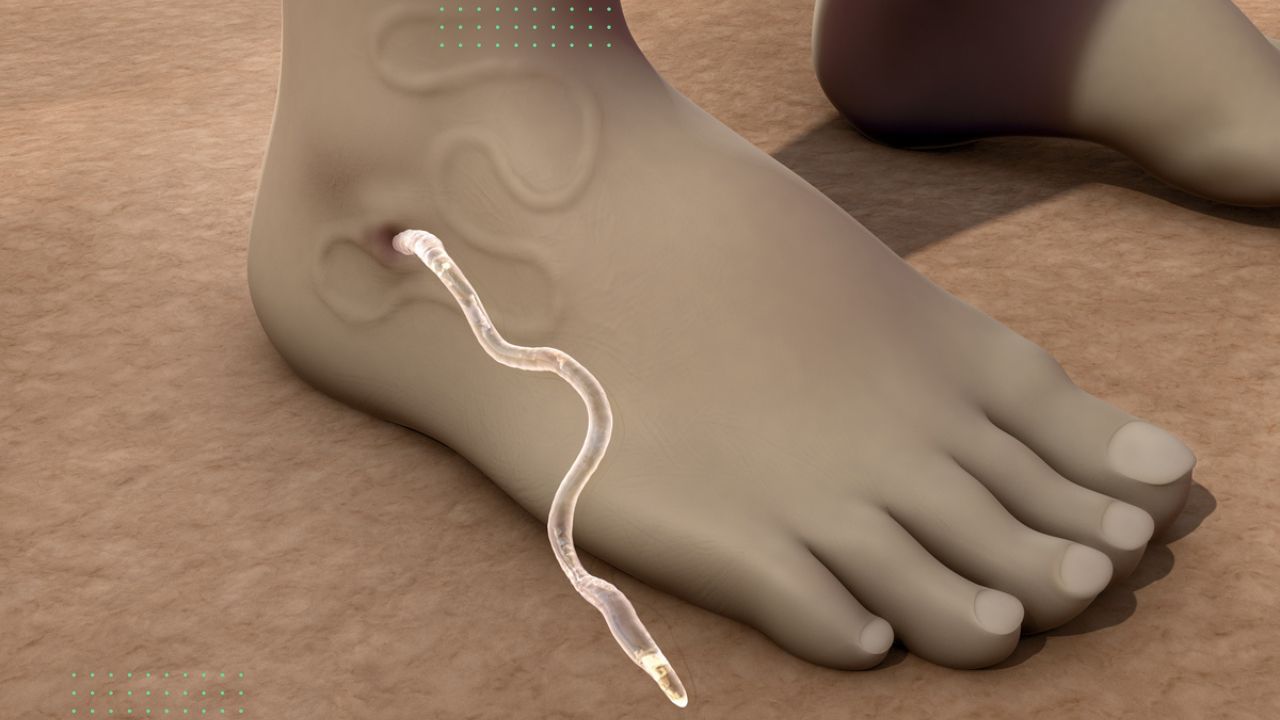Guinea worm disease, also known as dracunculiasis, is a parasitic infection caused by the nematode (roundworm) Dracunculus medinensis. The disease is spread through contaminated drinking water, typically in rural, impoverished areas with inadequate sanitation and access to clean water.
The life cycle of the Guinea worm begins when a person drinks water containing tiny copepods (water fleas) infected with Guinea worm larvae. The larvae mature inside the human body over the course of about a year, during which time they grow into long, thin worms that can measure up to 3 feet (1 meter) in length. The adult worms eventually emerge from the skin, typically on the lower limbs, causing a painful blister and a burning sensation.
The disease is not usually fatal, but it can cause disabling symptoms, including intense pain and fever, and the debilitating effect can last for months. There is no vaccine or cure for Guinea worm disease, but it can be prevented through simple measures such as filtering water and promoting hygiene and sanitation practices.
Efforts to control the disease have been successful in recent years, and the World Health Organization (WHO) is working towards the global eradication of Guinea worm disease. As of 2021, only a handful of cases were reported in Africa, which is a major decline from the millions of cases that occurred in the 1980s.
Symptoms Of Guinea Worm Disease
The symptoms of Guinea worm disease typically appear about a year after a person becomes infected with the larvae. The symptoms can include:
- A painful, burning sensation: As the adult worm begins to emerge from the skin, it can cause a painful, burning sensation. This is often accompanied by itching and a feeling of discomfort.
- A blister: As the worm emerges, it can cause a blister to form on the skin. The blister can be quite large and can be filled with fluid.
- Nausea and vomiting: In some cases, a person with Guinea worm disease may experience nausea and vomiting as a result of the pain and discomfort.
- Fever: A low-grade fever may be present in some cases.
- Ulceration: After the blister breaks, an ulcer may form, which can be painful and slow to heal.
- Infection: In some cases, the wound left by the Guinea worm can become infected, which can lead to further complications.
It’s important to note that the symptoms of Guinea worm disease can be quite severe and can significantly impact a person’s quality of life. If you suspect that you or someone you know may have Guinea worm disease, it’s important to seek medical attention as soon as possible.
Causes Of f Guinea Worm Disease
Guinea worm disease is caused by the parasitic nematode (roundworm) Dracunculus medinensis. The life cycle of the Guinea worm begins when a person drinks water containing tiny copepods (water fleas) infected with Guinea worm larvae. Once inside the human body, the larvae mature over the course of about a year, during which time they grow into long, thin worms that can measure up to 3 feet (1 meter) in length.
When the adult worm is ready to emerge from the skin, it causes a painful blister and a burning sensation. The person with the infection may then immerse the affected area in water to relieve the pain and discomfort, which triggers the release of thousands of larvae back into the water, perpetuating the cycle of infection.
The disease is typically found in rural, impoverished areas with inadequate sanitation and access to clean water. Contaminated drinking water is the primary source of transmission, and the disease is more common in areas where people rely on open sources of water such as ponds, rivers, and wells.
Prevention of Guinea worm disease involves ensuring that drinking water is filtered and safe to drink, promoting hygiene and sanitation practices, and educating people in affected areas about the disease and how to prevent its spread.
How Deadly Is Guinea Worm?
Guinea worm disease is not usually fatal, but it can cause significant disability and have a major impact on a person’s quality of life. The adult worm causes a painful blister and a burning sensation as it emerges from the skin, and this can make it difficult for a person to perform daily activities or work. The debilitating symptoms can last for months, and in severe cases, the infection can lead to secondary bacterial infections or other complications.
While Guinea worm disease is not usually fatal, it can have a significant impact on public health and economic development in affected areas. The disease is more common in rural, impoverished areas with inadequate sanitation and access to clean water, and it can limit people’s ability to work and earn a living.
Efforts to control and eliminate Guinea worm disease have been successful in recent years, and the World Health Organization (WHO) is working towards the global eradication of the disease. As of 2021, only a handful of cases were reported in Africa, which is a major decline from the millions of cases that occurred in the 1980s.
Where Is Guinea Worm Found?

Guinea worm disease is found primarily in rural, impoverished areas of Africa, particularly in regions with inadequate sanitation and access to clean water. The disease is endemic in several countries in sub-Saharan Africa, including Chad, Ethiopia, Mali, and South Sudan. In the past, the disease was also found in other parts of the world, including the Middle East, India, and Pakistan, but these regions have been largely free of the disease in recent years.
The Guinea worm life cycle depends on the presence of stagnant water, such as ponds, rivers, and wells, which can become contaminated with the parasite. People in affected areas may rely on these sources of water for drinking, bathing, and washing, making it difficult to prevent the spread of the disease. Preventing Guinea worm disease involves ensuring that drinking water is filtered and safe to drink, promoting hygiene and sanitation practices, and educating people in affected areas about the disease and how to prevent its spread.
Treatment Of Guinea Worm Disease
There is currently no specific treatment or medication for Guinea worm disease. Instead, the focus is on managing the symptoms and preventing further transmission of the disease.
When the worm begins to emerge from the skin, it can be wrapped around a small stick or piece of gauze, and then gently pulled out of the skin over several days. This process can be painful and may require pain medication to manage the discomfort. Once the worm is removed, the wound should be kept clean and covered to prevent infection.
Preventing transmission of the disease is also an important part of the treatment process. People with Guinea worm disease should avoid immersing the affected area in water, as this can release more larvae and perpetuate the cycle of infection. They should also avoid entering water sources such as ponds or rivers to prevent contamination.
Efforts to control and eliminate Guinea worm disease have been successful in recent years, and the World Health Organization (WHO) is working towards the global eradication of the disease. Preventive measures such as providing safe drinking water, promoting hygiene and sanitation practices, and educating people in affected areas about the disease and how to prevent its spread have been effective in reducing the incidence of Guinea worm disease.
How Is Guinea Worm Disease Spread?
Guinea worm disease is spread through the consumption of contaminated water. The disease is caused by the parasitic nematode (roundworm) Dracunculus medinensis. When a person drinks water containing tiny copepods (water fleas) infected with Guinea worm larvae, the larvae enter the body and mature into adult worms that can measure up to 3 feet (1 meter) in length.
Over the course of about a year, the adult worm grows and develops inside the human body. When the worm is ready to emerge, it causes a painful blister and a burning sensation. The person with the infection may then immerse the affected area in water to relieve the pain and discomfort, which triggers the release of thousands of larvae back into the water, perpetuating the cycle of infection.
The disease is more common in rural, impoverished areas with inadequate sanitation and access to clean water, where people may rely on open sources of water such as ponds, rivers, and wells for drinking and washing. Contaminated water is the primary source of transmission, and preventive measures such as providing safe drinking water, promoting hygiene and sanitation practices, and educating people in affected areas about the disease and how to prevent its spread have been effective in reducing the incidence of Guinea worm disease.
Prevention Of Guinea Worm Disease
Preventing Guinea worm disease involves several strategies, including:
- Providing safe drinking water: Access to clean, safe drinking water is crucial in preventing Guinea worm disease. Efforts to provide safe drinking water can include well-drilling projects, water treatment facilities, and distribution of water filters.
- Promoting hygiene and sanitation practices: Educating people in affected areas about the importance of washing hands, practicing good hygiene, and disposing of waste properly can help prevent the spread of Guinea worm disease.
- Filtering water: The use of fine mesh filters can remove copepods from water sources, preventing the transmission of Guinea worm disease.
- Treating contaminated water sources: Chemical treatment or other methods can be used to kill copepods in water sources, reducing the risk of transmission.
- Educating the community: Educating people in affected areas about the disease, its transmission, and how to prevent its spread can be an effective strategy in preventing Guinea worm disease.
Efforts to control and eliminate Guinea worm disease have been successful in recent years, and the World Health Organization (WHO) is working towards the global eradication of the disease. Preventive measures such as providing safe drinking water, promoting hygiene and sanitation practices, and educating people in affected areas about the disease and how to prevent its spread have been effective in reducing the incidence of Guinea worm disease.
